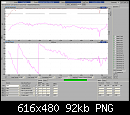Re: How to build a flat-phase DSP preset?
Hi Bennett, Silas, et. al.
I'm curious to understand what is meant by the desire for a flat-phase speaker or crossover? If we interpret the phrase as a loudspeaker that has no phase variation over it's whole frequency range, this is nigh impossible for a multi-way loudspeaker.
Firstly, if we consider a multi-way loudspeaker with utopian crossovers that have no phase shift and where the drivers are time aligned, the loudspeaker will only exhibit flat phase in one spatial direction (or plane). At all other listening positions, there is a slight difference in time arrival which is equivalent to non-flat phase. (Even the use of linear phase brick wall FIR crossovers can't prevent this. But they can reduce off axis lobing.)
Secondly, if we look at all IIR filter based crossovers, of which Linkwitz-Riley is one, they all have a phase that varies with frequency.
Thirdly, the use of IIR filter and minimum-phase FIR filter EQ to fix irregularities in a speaker's magnitude response will result in phase shifts - some minor and some major, depending on the choice of filter. Linear phase FIR filters are the exception but they have longer delay and can have audible pre-ringing.
I suspect the interest is just to have a multi-way loudspeaker where every driver exhibits positive pressure for positive voltage, where the drivers are time aligned, where the crossovers have a low amount of phase shift variation with frequency, and where the overall phase is consistent (for a given model of cabinet) so that cabinets can be arrayed. I suggest we're already there....
On the question of the audibility of phase, I'm not aware of evidence that people can detect absolute phase variations across frequency in a typical well designed single loudspeaker. However people can detect relative phase differences between two loudspeakers or sources. This can show up as frequency response irregularities, comb filtering, imaging problems and the like. (I remember evaluating a pair of studio monitors where in the crossover region, one loudspeaker was about 100 degrees different to the other. There were stereo imaging and level problems which were confirmed with test gear. We sent them back!) There is evidence from ABX testing that some people can disguish a difference between a positive signal and an inverted signal. (Some instruments like saxophones have a very asymmetric pressure waveform.) And there is evidence that time delay between drivers is problematic, but as I mentioned, we can already time align drivers with current speaker processors.
Best,
Michael
Silas,
Now I'm tempted to make a post about building a flat phase crossover, which is not so hard with any decent DSP. Let me see if I can get someone to take a few measurements for me...
Hi Bennett, Silas, et. al.
I'm curious to understand what is meant by the desire for a flat-phase speaker or crossover? If we interpret the phrase as a loudspeaker that has no phase variation over it's whole frequency range, this is nigh impossible for a multi-way loudspeaker.
Firstly, if we consider a multi-way loudspeaker with utopian crossovers that have no phase shift and where the drivers are time aligned, the loudspeaker will only exhibit flat phase in one spatial direction (or plane). At all other listening positions, there is a slight difference in time arrival which is equivalent to non-flat phase. (Even the use of linear phase brick wall FIR crossovers can't prevent this. But they can reduce off axis lobing.)
Secondly, if we look at all IIR filter based crossovers, of which Linkwitz-Riley is one, they all have a phase that varies with frequency.
Thirdly, the use of IIR filter and minimum-phase FIR filter EQ to fix irregularities in a speaker's magnitude response will result in phase shifts - some minor and some major, depending on the choice of filter. Linear phase FIR filters are the exception but they have longer delay and can have audible pre-ringing.
I suspect the interest is just to have a multi-way loudspeaker where every driver exhibits positive pressure for positive voltage, where the drivers are time aligned, where the crossovers have a low amount of phase shift variation with frequency, and where the overall phase is consistent (for a given model of cabinet) so that cabinets can be arrayed. I suggest we're already there....
On the question of the audibility of phase, I'm not aware of evidence that people can detect absolute phase variations across frequency in a typical well designed single loudspeaker. However people can detect relative phase differences between two loudspeakers or sources. This can show up as frequency response irregularities, comb filtering, imaging problems and the like. (I remember evaluating a pair of studio monitors where in the crossover region, one loudspeaker was about 100 degrees different to the other. There were stereo imaging and level problems which were confirmed with test gear. We sent them back!) There is evidence from ABX testing that some people can disguish a difference between a positive signal and an inverted signal. (Some instruments like saxophones have a very asymmetric pressure waveform.) And there is evidence that time delay between drivers is problematic, but as I mentioned, we can already time align drivers with current speaker processors.
Best,
Michael
Last edited:

